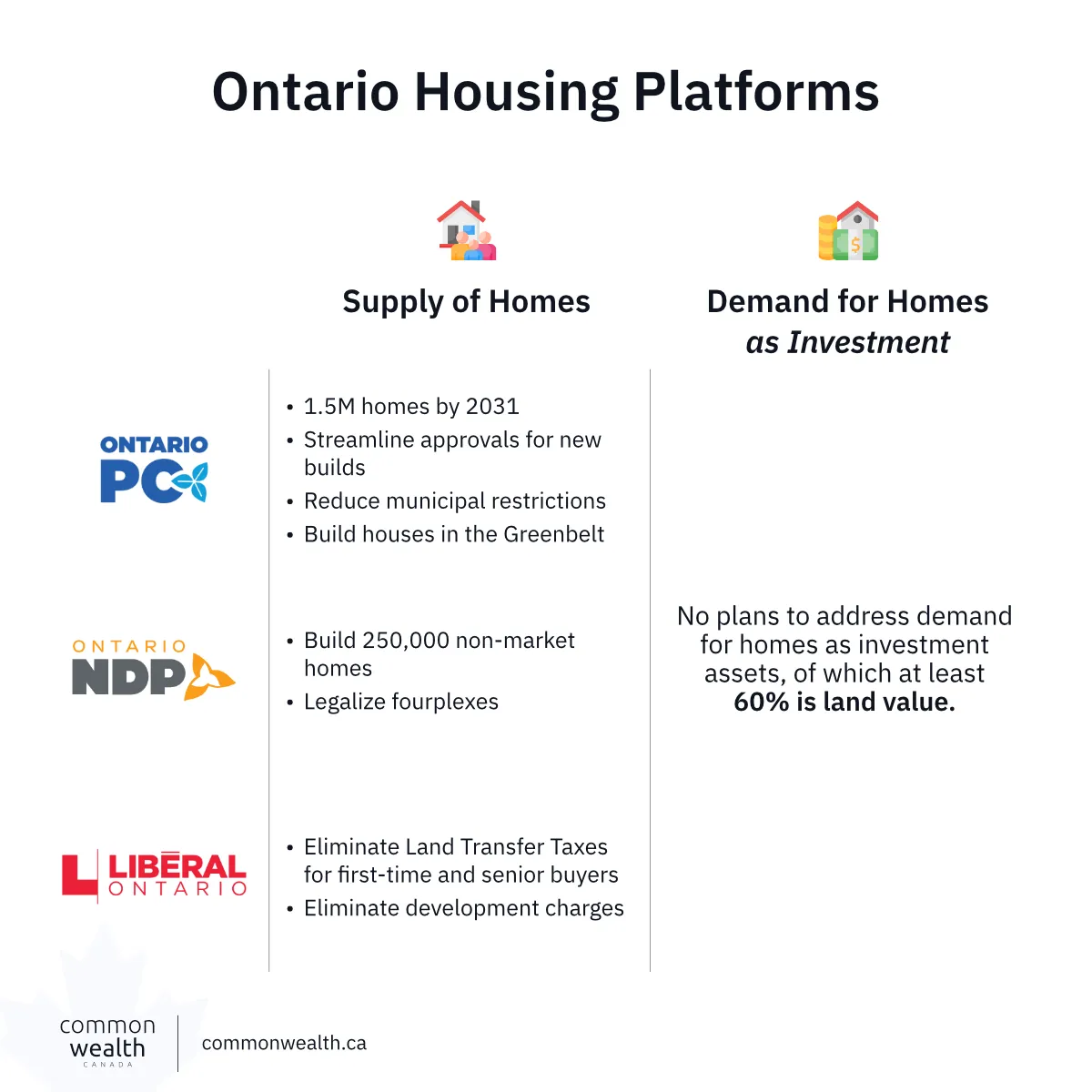Ontario Housing Plans — 2025 Election Edition
Housing Plans
Ontario’s major political parties—Progressive Conservatives, Liberals, and the NDP—all propose housing plans that focus primarily on supply-side solutions, aiming to increase the rate of new home construction. While more housing is essential, these proposals fail to acknowledge that the present crisis extends far beyond simple supply shortages. Even if homebuilding dramatically accelerates, it will struggle to keep pace with runaway housing inaccessibility driven by investment demand.
The core issue is that housing in Ontario is no longer just about shelter—it has become a highly financialized asset class. Investors, both small-scale “mom-and-pop” landlords and large institutional buyers, are increasingly outbidding each other to acquire properties, not only to use them, but because they expect land values to continue rising indefinitely. Single property homeowners are caught in this trap as well, willing to spend ever-more on a home because it is supposed to be a sound long-term investment . This speculative cycle fuels skyrocketing prices, pushing ownership and rental costs further out of reach for regular Ontarians.
A more effective solution would tackle the demand-side problem directly. A Land Value Tax (LVT)—which taxes the unimproved value of land rather than structures—could fundamentally disrupt this speculative cycle. By shifting the cost burden onto those who hoard land for profit rather than productive use, an LVT would discourage speculative buying, lower land prices, and make housing more affordable for actual residents. Unlike policies that merely subsidize home purchases or tweak rent control, an LVT addresses the root cause of Ontario’s housing crisis: excessive demand driven by market speculation.
With this context in mind, the following comparison outlines how each party’s housing plan attempts to tackle affordability—primarily through supply-side mechanisms—without directly confronting the speculative forces that continue to push prices higher.
Progressive Conservative (Doug Ford) Housing Plan
Target: Build 1.5 million homes by 2031.
Key Focus:
Streamlining approvals for additional residential units (e.g., basement apartments, garden suites).
Developing the Greenbelt for new housing despite significant public backlash.
Prioritizing supply-side solutions and partnerships with private developers.
Reducing municipal restrictions to accelerate new builds.
Liberal (Team Bonnie) Housing Plan
Cut Taxes:
Eliminate Ontario Land Transfer Tax for first-time homebuyers, seniors downsizing, and non-profit homebuilders.
Scrap Development Charges on new housing under 3,000 sq. ft., reducing costs by up to $170,000 per home.
Replace lost municipal revenue with the “Better Communities Fund” (BC Fund) to finance infrastructure.
Rental Market:
Phased-in rent control to prevent exploitative rent hikes.
Incentives for building more co-op and rental housing by eliminating punitive taxes like Community Benefits Charges.
Address Landlord-Tenant Board backlog with more resources and quicker case resolution.
Create the REST Fund for interest-free loans to tenants in financial emergencies.
Infrastructure and Smart Growth:
Prioritize transit-oriented developments and “missing middle” housing.
Maintain Development Charges for sprawl-inducing greenfield projects.
NDP (Marit Stiles) Housing Plan
Affordable Housing:
Build at least 250,000 permanently affordable, non-market homes.
Government-led housing initiatives to double supply by collaborating with municipalities, non-profits, and co-ops.
Leverage public land and low-cost financing to build affordable homes quickly.
Rental Market:
Legalize fourplexes and other “missing middle” housing across all neighborhoods.
Increase density along transit corridors as recommended by Ontario’s Housing Affordability Task Force.
Focus on Equity:
Emphasize housing as a right, ensuring affordability for middle- and working-class families.
Target deeply affordable homes for those priced out of the market and facing skyrocketing rents.
A Better Approach
At Common Wealth we believe that while reforms to increase the supply of housing are essential, they are insufficient. Taxing land value is a much more efficient, straightforward, and impactful way to end the housing crisis today. Rebating those revenues to Ontarians would also drastically increase affordability by increasing incomes, while lower land prices would reduce the size of mortgages and interest payments that are increasingly eating into our pocketbooks.
By placing a 1.8% tax on the value of all land, Ontario could immediately lower the price of land by 37%, which would in turn lower the cost of the average home by over $180,000. This tax would be sufficient to provide every Ontario household a rebate of $11,000 which would go a long way to address the present affordability crisis.
Read more about how LVT can lower the cost of housing.

